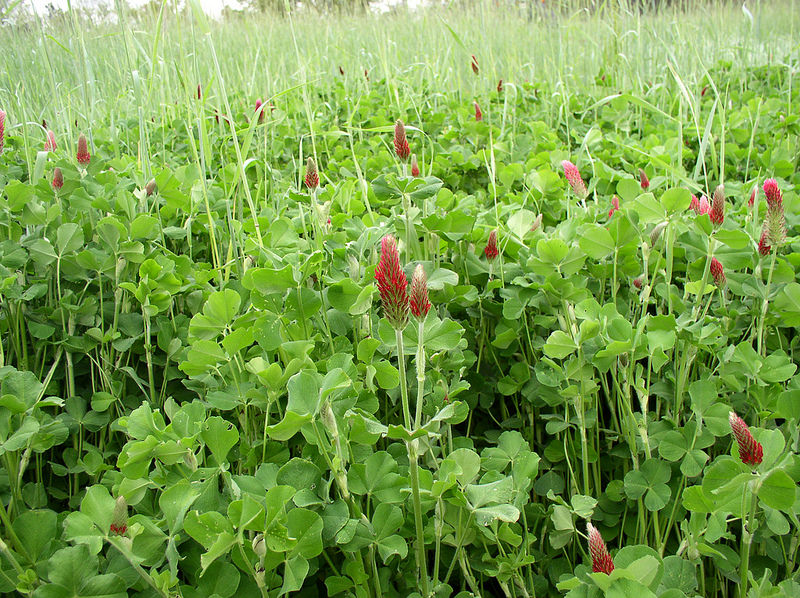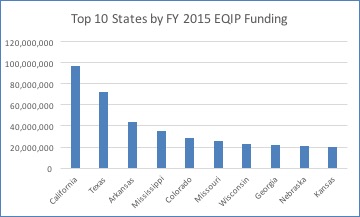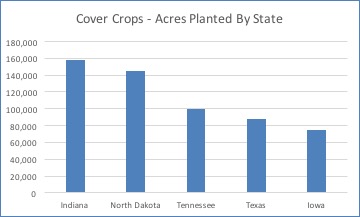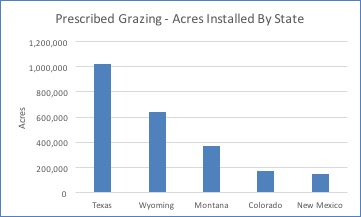What do Concentrated Animal Feeding Operations (CAFOs) and cover crops have in common? Both receive millions of dollars in funding each year through the Environmental Quality Incentives Program (EQIP). This post digs into EQIP data from Fiscal Year (FY) 2015 to highlight major conservation wins, as well as identify critical opportunities for improvements in this working lands conservation program.

In fiscal year (FY) 2015, the U.S. Department of Agriculture (USDA)’s Natural Resources Conservation Service (NRCS) obligated more than $861 million in financial assistance through the Environmental Quality Incentives Program (EQIP). EQIP provides farmers and ranchers with financial cost-share assistance and technical assistance to implement conservation practices on working agricultural land. EQIP assistance is available through a general pool, which is the focus of this analysis, as well as through special initiatives, which highlight specific practices, natural resources, or eco-regions. The $861 million analyzed in this post includes financial assistance through general EQIP and all special initiatives, but it does not reflect the additional EQIP funding for technical assistance and the Regional Conservation Partnership Program, totaling more than $1.3 billion.
EQIP participants install or implement structural, vegetative, and management practices on their land, and EQIP may share up to 75 percent of the costs for conservation practices, or up to 90 percent of project costs for socially disadvantaged, limited-resource, beginning, and veteran farmers and ranchers.
Demand for EQIP continues to exceed available funding. In FY 2015, only 23 percent of all eligible applications to general EQIP were funded. It is also important to note that acceptance rates vary significantly by state, which begs the question of how applications are being ranked, how well EQIP opportunities are being promoted, and why demand for funding differs so widely at the state and local levels. For instance, Iowa funded nearly 50 percent of eligible EQIP applications in FY 2015, while only 11 percent of eligible applications were funded in Illinois.
The chart below illustrates the top 10 states that received EQIP funding in FY 2015.
Sustainable Management Practices available through EQIP
Sustainable practices, including both vegetative and land management practices, are of particular importance to EQIP’s ability to address priority resource concerns. Examples of these critical practices available through EQIP in FY 2015 include crop rotations, cover cropping, reduced or no till, integrated pest management (IPM), irrigation water management, and prescribed grazing.
In total, NRCS obligated over $230 million in EQIP funding to provide assistance for sustainable management practices, which accounted for 24 percent of all funding in FY 2015.
Cover crops topped the list of these practices in FY 2015, as NRCS provided nearly $53 million in EQIP financial and technical assistance for cover cropping last year. Cover crops, which include grasses, legumes, and other seasonal vegetative cover, help producers to reduce erosion, improve soil health, suppress weed pressures, and reduce water quality degradation. In terms of the amount of funding obligated through EQIP, support for cover crops was the second highest ranking practice, receiving 6 percent of total funding, and ranking just below support for fencing.
As the chart below illustrates, the top 5 states to plant cover crops, by acreage, in FY 2015 were Indiana, North Dakota, Tennessee, Texas, and Iowa.
Providing similar benefits for livestock producers, and ranking over $13 million were obligated to implement prescribed grazing on land covering over 3 million acres throughout the country. Through this practice, producers receive financial and technical assistance to manage the harvest of vegetation with the grazing and/or browsing of animals. Prescribed grazing enables producers to improve species diversity and plant vigor, mitigate erosion, support water quality, and improve the quality of food available for livestock and wildlife.
The chart below illustrates the top 5 states, by acreage, that implemented prescribed grazing, which include Texas, Wyoming, Montana, Colorado, and New Mexico.
Three additional land management and vegetative practices that received significant funding through EQIP in FY 2015 include conservation crop rotation ($10,377,031), conservation cover ($3,702,093), and grassed waterways ($3,651,020).
Support for Animal Feeding Operations Continues
While the National Sustainable Agriculture Coalition (NSAC) is supportive of the $230 million of EQIP funding that go to support practices like cover crops and prescribed grazing, we continue to advocate that a much larger percentage of of these conservation dollars should be available for small and mid-sized family farmers and to sustainable grazing systems. Unfortunately, a significant amount of funding goes toward large payments to concentrated animal feeding operations (CAFOs) through funding for waste lagoons, waste transfer, and waste treatment.
These CAFO practices have dubious environmental benefits and even in some cases in a net loss of conservation benefits. NSAC continues to contend that NRCS must stop providing EQIP assistance for building out new or expanding CAFOs in areas with impaired waters, on floodplains, and in excess nutrient regions. Despite the negative environmental impacts resulting from the development and expansion of CAFOs, animal waste storage and treatment facilities is the second largest single user of EQIP funds (behind only irrigation equipment), which in turn reduces funds that would otherwise be available for sustainable management practices.
In FY 2015 alone, NRCS provided more than $100 million in EQIP funding for CAFO-related practices. This amounts to nearly 12 percent of total EQIP funding that could have otherwise gone to support management based practices. CAFO practices that received significant EQIP cost share support in FY 2015 include waste storage facility ($48,718,300), waste facility cover ($23,979,393), animal mortality facility ($8,106,818), and manure transfer ($7,924,843).
Irrigation Funding
An additional concern regarding EQIP funding is the fact that irrigation practices continue to make up the largest percentage (more than 17 percent) of total funding in FY 2015. More than $146 million of EQIP funds went to support irrigation practices, including $49 million for pivot sprinkler systems and another $36 million for irrigation pipeline.
Funding for irrigation practices such as pipelines and pivots is particularly concerning in cases when support may help improve irrigation efficiency, but savings is used to expand irrigated crop production. We have advocated that producers should not use irrigation efficiency payments to bring new land into production, thereby further reducing in-stream flows, but unfortunately these important clarifications were not made part of the 2014 Farm Bill. Further investigation and program evaluation is needed to ensure the public investment is leading to water conservation and improved stream health.
Conservation Stewardship Program Data Coming Soon
In addition to EQIP, the Conservation Stewardship Program (CSP) is the farm bill’s other large working lands conservation program. While EQIP provides one-time assistance to correct a problem or add farm infrastructure, CSP provides ongoing performance-based stewardship payments to support advanced conservation systems.
Stay tuned for a follow-up post that will dig into CSP activities selected and enrollment numbers from FY 2015.




